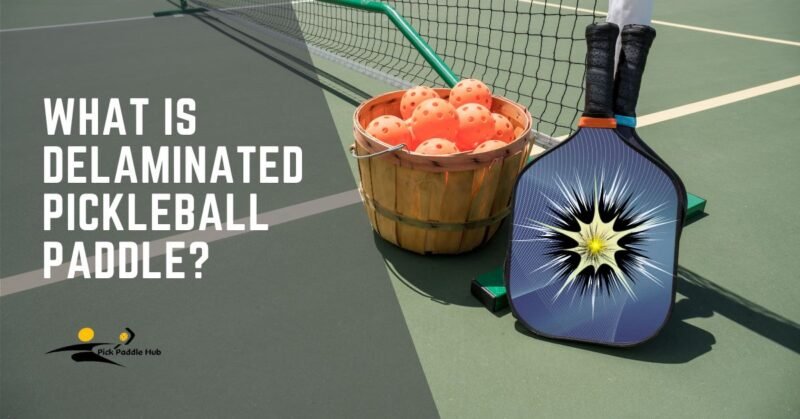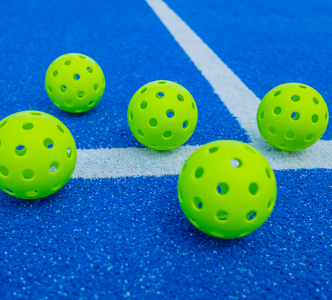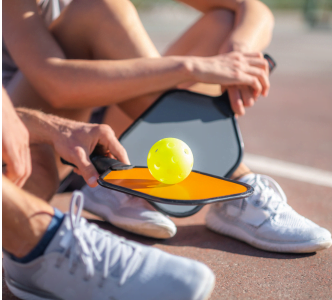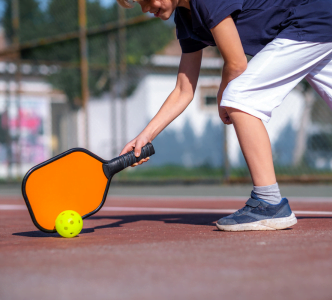Have you ever found yourself in the middle of an intense pickleball game, only to feel your paddle just doesn’t have that ‘oomph’ it used to?
Well, you might be dealing with what’s known in the pickleball community as a delaminated pickleball paddle. This common issue can throw a wrench in your gameplay, affecting everything from the paddle’s grip to its overall power and control.
Today We’ll explore what is a delaminated pickleball paddle, what causes this frustrating condition, how to spot it, and most importantly, the steps you can take to prevent and fix it.
You should know The ins and outs of paddle delamination to keep your game strong and your shots precise. So, let’s get into it and ensure that your pickleball paddle stays in top condition, ready to face any challenge on the court.
What is a delaminated pickleball paddle?
Imagine stepping onto the court, paddle in hand, ready to dominate the game. But something feels off. The power behind your shots isn’t what it used to be, and the paddle itself feels strangely uneven.
You, my friend, might just be experiencing the woes of a delaminated pickleball paddle. But what exactly does that mean?
In simple terms, a delaminated pickleball paddle is characterized by the separation or detachment of its layers. This isn’t just a minor inconvenience, it’s a full-blown issue that can drastically reduce your paddle’s effectiveness.
Delamination can lead to dead spots where the ball doesn’t bounce off your paddle quite right, reducing your control and the power of your shots. It’s like trying to play your best game with one hand tied behind your back—not exactly ideal.
You might be wondering, “How does this even happen?” Well, paddle delamination can result from normal wear and tear, exposure to extreme temperatures, or even manufacturing defects. Regardless of the cause, the result is a paddle that’s not performing at its peak, potentially turning your game into more of a struggle than a showcase of skill.
Why Delamination in Paddles is a Problem?
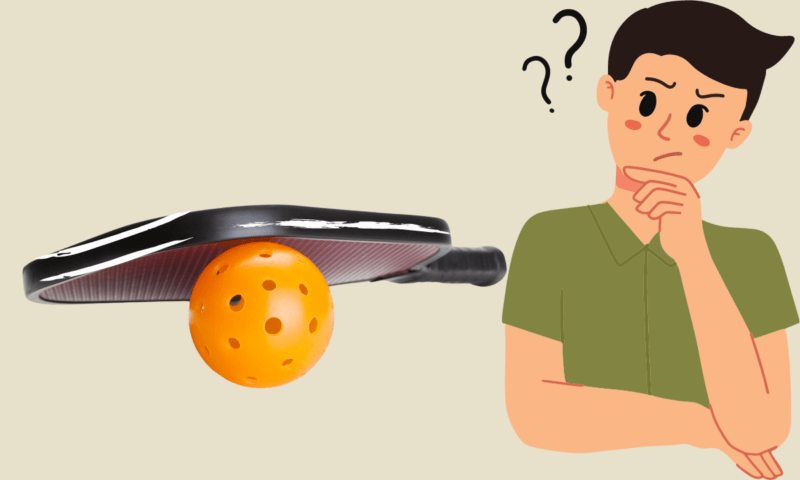
Delamination in pickleball paddles isn’t just a minor hiccup; it’s a serious issue that can stir up quite a controversy among players. Here’s the scoop on why delamination gets under a player’s skin and why it’s a topic of heated discussions in pickleball forums and clubs.
First off, when your paddle delaminates, it’s like losing a trusted teammate. The layers of the paddle, which once worked in harmony to give you that crisp, satisfying pop with every shot, start to separate or come apart. This separation leads to inconsistencies in how the ball reacts when it hits different parts of the paddle, making it tricky to play with precision and confidence.
Imagine trying to ace your serve, only for the ball to barely make it over the net because it hit a dead spot on your paddle. Frustrating, right?
Moreover, delamination can be seen as a reflection of quality and durability. When players invest in a high-quality paddle, they expect it to withstand the rigours of intense gameplay.
A delaminated paddle can, therefore, spark debates about manufacturing practices, materials used, and whether certain brands are cutting corners. It’s not just about the annoyance of playing with a defective paddle, it’s about the expectation of quality that comes with the sport’s growing popularity.
The controversy doesn’t stop there. The rules around equipment in official tournaments can further fuel the fire. If a paddle is delaminated, it might not meet the official specifications for play, leaving players at a disadvantage or even disqualifying them from a match.
This adds an extra layer of urgency to understanding and addressing paddle delamination, highlighting the importance of maintenance, care and cleaning in preserving the integrity of one’s equipment.
What Does a Delaminated Pickleball Paddle Look Like?

Identifying a delaminated pickleball paddle might not always be straightforward, especially if you’re new to the game. But knowing what to look out for can save you from the surprise of a paddle giving out at a crucial moment.
First up, The visual clues
Delamination often presents itself as visible bubbles or bulges on the paddle’s surface. These aren’t the normal wear and tear you’d expect from spirited gameplay; they’re signs that the layers beneath the surface are starting to part ways.
In some cases, you might notice the outer layer peeling away at the edges, much like wallpaper that’s seen better days. This peeling can start small, but it’s a clear indicator that the integrity of the paddle is compromised.
Then there’s the auditory and tactile evidence
A delaminated paddle doesn’t sound the same when it strikes the ball. Instead of the solid, satisfying ‘pop’ you’re used to, it might produce a duller, hollow sound. This is your cue that something’s amiss.
Similarly, the feel of the paddle in your hand can change. It might feel less stable, or you could detect a shift in weight or balance due to the separation of layers. This altered feel can significantly impact your control and precision during play.
Finally, the performance test
If you’re noticing that your shots are less powerful than before, or the ball isn’t rebounding as it should, delamination could be the culprit. These performance issues are particularly telling because they directly affect your game, signalling that it’s time to take a closer look at your paddle.
What Causes Pickleball Paddle Delamination?
Understanding what leads to delamination can help you prevent this paddle predicament from sidelining your game. It’s a bit like playing detective, piecing together clues to protect your gear. Here are the usual suspects in the case of delaminated pickleball paddles:
- Exposure to Extreme Temperatures:
- Pickleball paddles can be damaged by extreme weather.
- Leaving a paddle in a hot car or cold conditions weakens the adhesive between layers, causing them to separate.
- Impact Damage:
- Aggressive gameplay and impacts with the ground, net, or hard surfaces can cause internal damage.
- Damage may not be visible immediately but can lead to delamination over time.
- Wear and Tear:
- Constant use and lack of proper care can wear down the materials of a paddle.
- Over time, this wear can cause the layers of the paddle to separate.
- Manufacturing Defects:
- Defects from the manufacturing process can make a paddle more susceptible to delamination, even with normal use.
- Moisture:
- Paddles, especially those with wooden components, are sensitive to moisture.
- Excessive moisture can weaken the glue and materials, leading to the separation of the layers.
How to Prevent Delaminated Pickleball Paddle?

Preventing delamination in your pickleball paddle is akin to taking care of a cherished possession—it requires attention, care, and a bit of know-how.
By adopting a proactive approach, you can extend the life of your paddle and ensure it remains a reliable partner on the court. Here are some strategies to keep your paddle in top shape:
- Avoid Extreme Temperatures
- Use a Paddle Cover
- Handle with Care
- Regular Maintenance
- Inspect Regularly
Avoid Extreme Temperatures
Just as you wouldn’t leave a pet in a hot car, don’t leave your paddle in conditions that could cause it harm. Store it in a temperature-controlled environment to prevent the glue from melting or becoming brittle, which can lead to delamination.
Use a Paddle Cover
Think of a paddle cover as armor for your paddle. It protects against scratches, dings, and other forms of impact damage that could compromise the integrity of your paddle over time.
Handle with Care
While pickleball can get competitive, remember to treat your paddle gently. Avoid banging it against the ground or net in frustration or excitement. These impacts can weaken the paddle’s structure, making it more susceptible to delamination.
Regular Maintenance
Wipe down your paddle after use to remove dirt, sweat, and moisture. This simple act can prevent buildup that might degrade the materials and lead to separation of the layers.
Inspect Regularly
Make it a habit to check your paddle for signs of wear, such as cracks, peeling, or changes in texture. Early detection of potential issues can help you address them before they lead to delamination.
Solutions for Delaminated Pickleball Paddles
When you discover that your beloved pickleball paddle has delaminated, it’s not necessarily the end of the road. There are steps you can take to either breathe new life into it or make an informed decision on its future. Let’s explore the solutions available for delaminated pickleball paddles:
Repair Options
- Professional Repair: Some manufacturers or speciality shops offer repair services for delaminated paddles. They have the expertise and materials to properly reattach the layers, restoring the paddle’s performance. It’s worth checking if your paddle is still under warranty or if the manufacturer provides repair services.
- DIY Fixes: For the hands-on player, there are DIY methods to fix a delaminated paddle, involving glue and clamps to press the layers back together. However, proceed with caution: DIY repairs require a good understanding of the materials and process to avoid further damage. Only attempt this if you’re confident in your abilities and have researched the proper technique.
When to Replace
- Beyond Repair: If the delamination is extensive or the paddle’s structure is compromised, it might be time to consider a replacement. Continuously playing with a severely damaged paddle can affect your game and lead to bad habits or even injuries.
- Performance Issues: Even after attempting repairs, if the paddle no longer performs as it should or feels different in a way that impacts your play, seeking a new paddle might be the best route. Advances in paddle technology could also mean an upgrade offers benefits beyond just fixing the delamination issue.
Choosing a New Paddle
When shopping for a new paddle, consider the lessons learned from your previous experience. Look for paddles known for their durability and resistance to delamination. Read reviews, ask for recommendations from fellow players, and possibly test different paddles if you have the opportunity. Investing in a high-quality paddle can save you from future delamination woes and enhance your overall gameplay.
Conclusion
Facing a delaminated pickleball paddle isn’t the end but a challenge to be met with knowledge and action. Through this guide, you’ve gained the insights to spot, stop, and solve delamination, keeping your paddle game-ready and resilient.
The care you invest in your paddle reflects your commitment to the sport and your gameplay. So, stay vigilant, act swiftly at the first sign of wear, and keep your paddle in prime fighting form. Here’s to your next victory on the court, with a paddle that’s as steadfast and strong as your spirit. Let the game continue!
FAQs
What is delamination in a pickleball paddle?
Delamination occurs when the layers of a pickleball paddle separate or peel apart, often due to factors like extreme temperatures, impact damage, or wear and tear. This separation can affect the paddle’s performance, leading to reduced power and control over the ball.
How do you know if a pickleball paddle is bad?
A paddle might be considered “bad” or damaged if it shows signs of delamination, such as bubbling, peeling, or changes in sound when hitting the ball. Additionally, a noticeable decrease in performance, like reduced shot accuracy or power, can also indicate a paddle is no longer in optimal condition.
Is there a difference between pickleball paddles?
Yes, there are significant differences between pickleball paddles in terms of materials, weight, size, and surface texture. These variations can affect a paddle’s durability, control, power, and overall feel, making it important to choose a paddle that matches your playing style and preferences.
How do you identify a pickleball paddle?
Identifying a pickleball paddle involves looking at its characteristics, such as its material composition (wood, composite, or graphite), weight, shape, and surface texture. These features can help determine the paddle’s intended use, level of play, and how it might perform on the court.
How do you tell if a paddle is delaminated?
A delaminated paddle can be identified by visual inspection for bubbling or peeling layers, listening for dull or hollow sounds when the ball is struck, feeling for changes in the paddle’s balance or stability, and noticing a decline in performance during play.
What does a delaminated paddle mean?
A delaminated paddle means that the adhesive bonds holding the paddle’s layers together have failed, causing the layers to separate. This structural damage compromises the paddle’s integrity and performance, affecting players’ ability to control and power their shots effectively.

